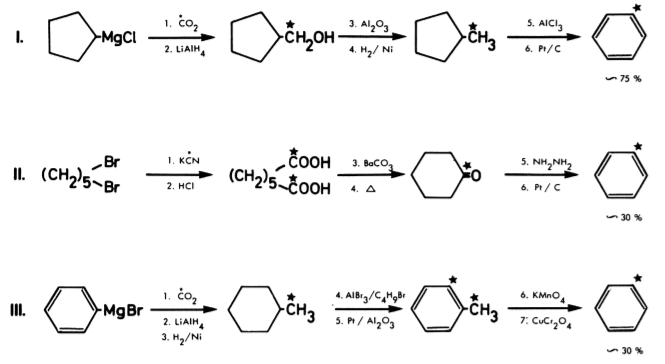The current methods employed for synthesis fall into the following three categories1:
- Chemical synthesis
- Biochemical methods
- Isotope exchange reactions
Chemical Synthesis:
Most chemical syntheses involving $\ce{^14 C}$ are done with Grignard reagent and $\ce{^14 CO2}$ or $\ce{^14 CN-}$. As an example, Benzene-14 is synthesized as such2:

Basic preparatory methods such as the above have been worked out long ago. An example of a more complex synthesis would be preparation of 18F-Fluorodeoxyglucose:

Biochemical methods
A few examples of these, as mentioned in (1), are:
High yields of [U-14C]sucrose, up to 70% based on $\ce{^14 CO2}$, are obtainable in detached leaves after a few hours photosynthesis using tobacco or Canna indica leaves for example.
DNA labelled either with $\ce{^14 C}$ or with $\ce{^3 H}$ is prepared by feeding E.coli with the correspondingly labelled thymine precursor. Similarly, by feeding [$\ce{^35 S}$]sulphate to E.coli or to yeast cells, isolation and hydrolysis of the proteins yields L.[$\ce{^35S}$]methionine and L-[$\ce{^35 S}$]cystine in radiochemical yields of 30% and 10% respectively.
Another example is the synthesis of C-14 labelled Phenylpyruvic acid3

Isotope exchange reactions
These are fairly common for atoms that can easily be exchanged, such as replacing $\ce{^23 Na}$ for $\ce{^24 Na}$, which was mentioned in the question. Another common mechanism for synthesis of Hydrogen isotope compounds is Hydrogen-Deuterium exchange. A similar mechanism also allows hydrogen-tritium exchange4.
Purification of radiolabelled compounds
This is mainly done through Chromatography1, as the amount of radiolabelled substrate required is generally quite small. High-performance liquid chromatography is used to separate the compounds. The chemical identity of the compounds is confirmed by co-chromatographic behaviour with the unlabelled compound.
For further information, refer to the references (1) and (3), which go into a lot more detail with regards to the synthesis of these compounds.
References:
- Anthony Evans, E. “Synthesis of Radiolabelled Compounds.” Journal of Radioanalytical Chemistry, vol. 64, no. 1–2, Mar. 1981, pp. 9–32. doi:10.1007/BF02518337.
- Schmid, K., et al. “A Simple Method of Preparing Labeled Benzene.” Advances in Tracer Methodology, edited by Seymour Rothchild, Springer US, 1966, pp. 37–44. doi:10.1007/978-1-4684-8625-4_5.
- Atzrodt, Jens, and John Allen. “Synthesis of Radiolabeled Compounds for Clinical Studies.” Drug Discovery and Evaluation: Methods in Clinical Pharmacology, edited by Hans Gerhard Vogel et al., Springer Berlin Heidelberg, 2011, pp. 105–18. doi:10.1007/978-3-540-89891-7_12.
- Englander, S. W., and J. J. Englander. “[3] Hydrogen—Tritium Exchange.” Methods in Enzymology, vol. 49, Academic Press, 1978, pp. 24–39. doi:10.1016/S0076-6879(78)49005-6.





